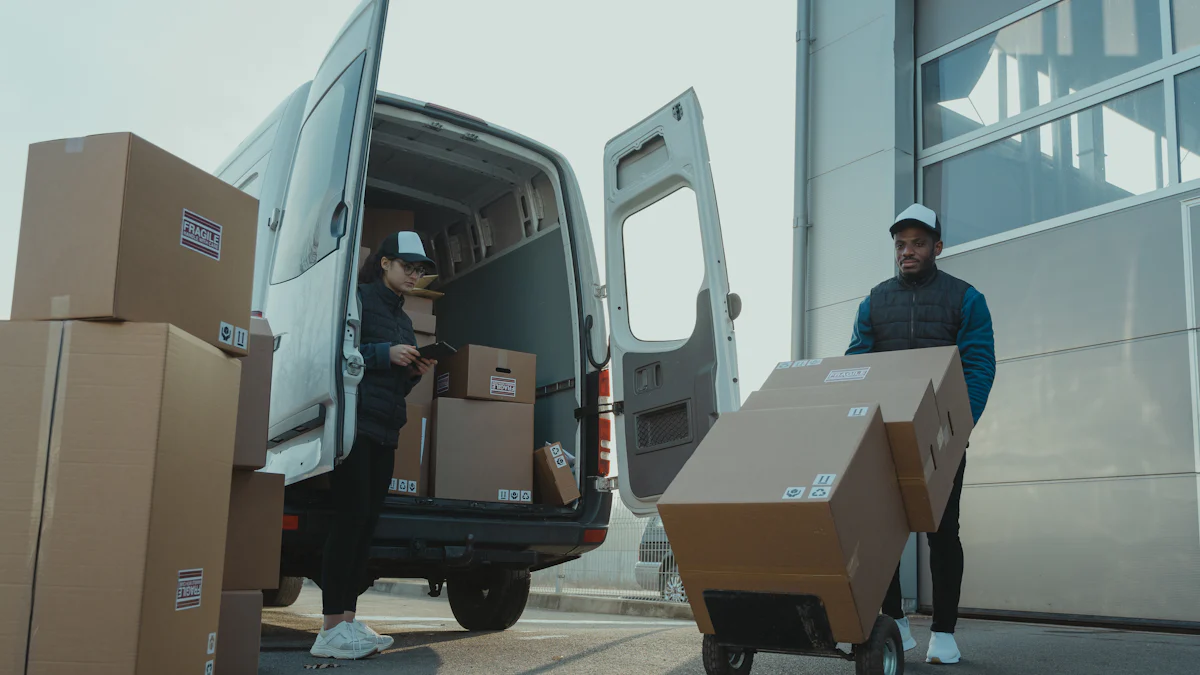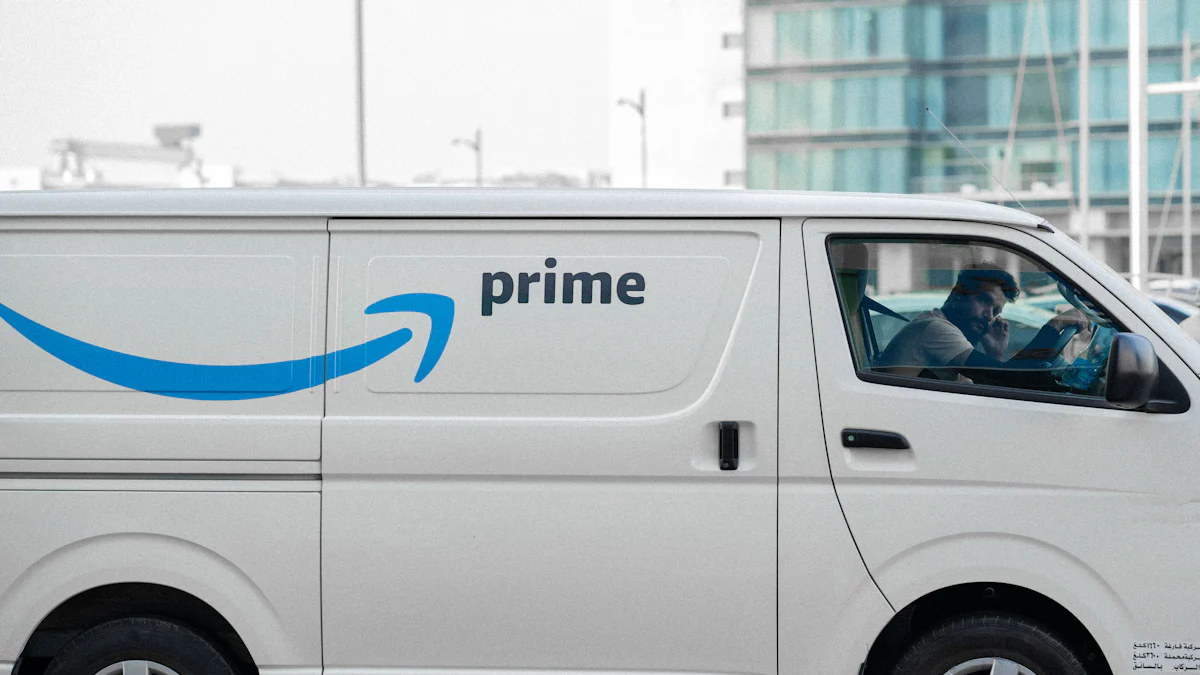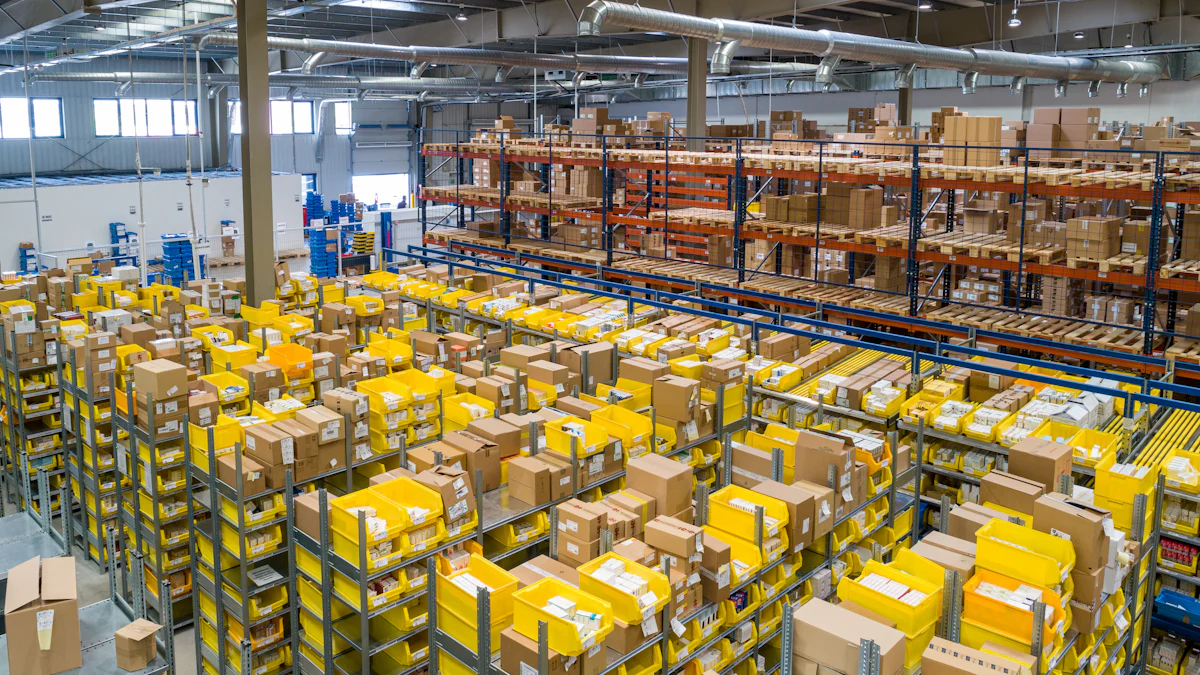
Choosing the right Amazon FBA shipping method can make or break your business. It impacts your costs, delivery times, and how satisfied your customers feel. You need to think about how to choose the right option for your shipment size and budget. Your business goals also play a big role. Are you aiming for faster delivery or lower expenses? Every decision matters when it comes to shipping. By making smart choices, you’ll save money and keep your customers happy.
Key Takeaways
- Evaluate your shipment size and budget to choose between Small Parcel Delivery (SPD), Less Than Truckload (LTL), or Full Truckload (FTL) methods.
- Consider using Amazon Partnered Carriers for discounted rates and streamlined shipping processes, especially if you're new to FBA.
- Always analyze the total shipping costs, including hidden fees, to avoid overspending and protect your profit margins.
- Prioritize delivery speed based on your business needs; faster methods may cost more but can enhance customer satisfaction.
- Ensure compliance with Amazon's FBA guidelines to prevent shipment rejections and additional fees.
- Test different shipping methods with small shipments to find the most efficient and cost-effective option for your business.
- Regularly monitor and adjust your shipping strategy based on performance data and customer feedback to optimize operations.
Choose the Right Amazon FBA Shipping Method

When it comes to shipping your products to Amazon’s fulfillment centers, you need to choose the right method that aligns with your business needs. Each option has its own advantages, and understanding them will help you make informed decisions.
Small Parcel Delivery (SPD)
Small Parcel Delivery (SPD) works best for smaller shipments. If you’re sending individual boxes or packages that weigh less than 150 pounds each, this method is ideal. You can rely on carriers like UPS or FedEx to handle these deliveries. SPD is a great choice if you’re just starting out or if your inventory size is small.
This method offers flexibility. You can ship items as needed without waiting to fill a truck. It’s also easier to manage because you don’t need to worry about pallets or large-scale logistics. However, keep in mind that SPD can become costly if you’re shipping high volumes. Always compare rates to ensure you’re getting the best deal.
Less Than Truckload (LTL)
Less Than Truckload (LTL) shipping is perfect for medium-sized shipments. If your goods are too large for SPD but don’t fill an entire truck, LTL is the way to go. With this method, your shipment shares space with other sellers’ goods. This helps reduce costs since you’re only paying for the portion of the truck you use.
LTL shipping requires pallets, so you’ll need to prepare your products accordingly. It’s a cost-effective option for businesses scaling up their operations. However, delivery times may be slightly longer because the truck makes multiple stops. If you’re not in a rush, LTL can save you money while still meeting your shipping needs.
Full Truckload (FTL)
Full Truckload (FTL) shipping is the best option for large shipments. If you have enough inventory to fill an entire truck, FTL ensures your products are transported directly to the fulfillment center. This method eliminates the need for sharing space with other shipments, reducing the risk of damage or delays.
FTL offers faster delivery times compared to LTL. Since the truck doesn’t make additional stops, your goods arrive more quickly. While FTL can be more expensive upfront, it’s often the most efficient choice for high-volume sellers. If your business handles bulk shipments regularly, FTL provides reliability and speed.
Amazon Partnered Carriers
Amazon Partnered Carriers offer a convenient and cost-effective way to ship your products to Amazon’s fulfillment centers. These carriers, such as UPS, work directly with Amazon to provide discounted shipping rates for sellers like you. If you’re looking to streamline your logistics while keeping costs low, this option might be the perfect fit.
Using Amazon Partnered Carriers simplifies the shipping process. You can create your shipment directly in your Seller Central account and choose the partnered carrier option. Once you’ve done that, you’ll receive a shipping label at a discounted rate. This method saves you time because you don’t need to negotiate rates or compare multiple carriers. It’s all handled within Amazon’s system.
Another advantage is reliability. Since these carriers work closely with Amazon, they understand the specific requirements for FBA shipments. They ensure your products meet Amazon’s guidelines, reducing the risk of delays or rejections. This partnership also means your shipments are tracked efficiently, giving you peace of mind.
However, it’s essential to evaluate whether this method aligns with your business needs. While the rates are competitive, they may not always be the cheapest for every shipment size or distance. For smaller shipments, Amazon Partnered Carriers often provide excellent value. For larger shipments, you might want to compare this option with others like LTL or FTL to ensure you choose the right method.
If you’re new to FBA or want a hassle-free shipping experience, Amazon Partnered Carriers can be a great starting point. They combine affordability, convenience, and compliance, making them a popular choice among sellers.
Key Factors to Consider When You Choose the Right Shipping Method
When deciding on the best shipping method for your Amazon FBA business, you need to evaluate several critical factors. These considerations will help you make informed choices that align with your goals and ensure smooth operations.
Cost
Shipping costs can significantly impact your profit margins. You should carefully analyze the expenses associated with each shipping method. Small Parcel Delivery (SPD) might seem convenient, but it can become expensive for high-volume shipments. Less Than Truckload (LTL) and Full Truckload (FTL) options often provide better value for larger shipments.
To save money, compare rates from different carriers. Amazon Partnered Carriers often offer discounted rates, which can help reduce costs. Don’t forget to factor in additional fees like packaging materials, storage, and handling charges. By understanding the total cost, you’ll avoid surprises and keep your budget under control.
Delivery Speed
Delivery speed plays a crucial role in customer satisfaction. Faster shipping methods, like SPD or FTL, ensure your products reach Amazon’s fulfillment centers quickly. If you’re dealing with time-sensitive inventory, prioritize speed to avoid stockouts or delays.
However, faster delivery often comes at a higher cost. If your business can handle slightly longer lead times, LTL shipping might be a more economical choice. Always balance speed with cost to find the right fit for your business needs.
Product Type and Size
The type and size of your products heavily influence your shipping method. Smaller, lightweight items are ideal for SPD. This method allows you to ship individual boxes without worrying about pallets or large-scale logistics. For bulkier or heavier items, LTL or FTL shipping becomes more practical.
Fragile or high-value products require extra care. You’ll need to ensure they’re packaged securely and handled properly during transit. Some carriers specialize in specific product types, so choose one that meets your requirements. By matching your shipping method to your product characteristics, you’ll minimize risks and optimize efficiency.
Geographic Coverage
Geographic coverage matters when selecting the right Amazon FBA shipping method. You need to think about where your products are going and how far they need to travel. Some shipping methods work better for local deliveries, while others handle long-distance or international shipments more efficiently.
If you’re shipping within the same region or country, Small Parcel Delivery (SPD) often provides a reliable and straightforward option. For larger shipments that need to travel across states or regions, Less Than Truckload (LTL) or Full Truckload (FTL) shipping might be more suitable. These methods can handle bulk goods over longer distances without breaking the bank.
For international shipments, you’ll need to consider customs, duties, and additional fees. Amazon Partnered Carriers can simplify this process by offering services tailored to cross-border shipping. They often include features like customs clearance and tracking, which can save you time and reduce headaches.
Always evaluate the shipping zones and regions your carrier covers. Some carriers specialize in specific areas, while others offer broader coverage. Choosing a method that aligns with your geographic needs ensures your products reach their destination without unnecessary delays or complications.
Reliability and Compliance
Reliability and compliance play a huge role in ensuring smooth shipping operations. You want a shipping method that consistently delivers your products on time and in good condition. Unreliable shipping can lead to delays, damaged goods, and unhappy customers.
Amazon has strict FBA guidelines, so compliance is non-negotiable. Your chosen shipping method must meet Amazon’s requirements for packaging, labeling, and delivery. Amazon Partnered Carriers often excel in this area because they understand these rules and help you stay compliant.
When evaluating reliability, look at the carrier’s track record. Do they have a history of on-time deliveries? How do they handle issues like lost or damaged shipments? Reading reviews or asking for recommendations can give you valuable insights.
To ensure compliance, double-check your shipping plan before sending products. Make sure your packaging meets Amazon’s standards and that all labels are accurate. A small mistake can result in delays or additional fees, so attention to detail is key.
By prioritizing reliability and compliance, you’ll avoid unnecessary problems and keep your business running smoothly. This approach not only saves you time and money but also builds trust with your customers.
Step-by-Step Guide to Choose the Right Amazon FBA Shipping Method
Choosing the right shipping method for your Amazon FBA business doesn’t have to feel overwhelming. By following a clear process, you can make decisions that align with your goals and keep your operations running smoothly. Here’s a step-by-step guide to help you navigate the process.
Create a Shipping Plan
Start by creating a detailed shipping plan. This plan acts as your roadmap, outlining what you’re shipping, where it’s going, and how you’ll get it there. Log in to your Amazon Seller Central account and use the “Send to Amazon” workflow to begin. This tool helps you organize your shipments and ensures compliance with Amazon’s requirements.
When building your plan, consider the size, weight, and type of your products. Are you shipping small, lightweight items or larger, bulkier goods? These details will influence your choice of shipping method. Also, think about your budget and delivery timeline. If you need faster delivery, you might lean toward Small Parcel Delivery (SPD) or Full Truckload (FTL). For cost savings, Less Than Truckload (LTL) could be a better fit.
A well-thought-out shipping plan saves time and reduces errors. It also ensures your products arrive at Amazon’s fulfillment centers without unnecessary delays.
Compare Shipping Options
Once you have your shipping plan, compare the available options. Each method—SPD, LTL, FTL, or Amazon Partnered Carriers—has unique benefits. To make the best choice, evaluate how each option aligns with your needs.
For smaller shipments, SPD offers flexibility and convenience. If you’re scaling up and shipping medium-sized loads, LTL provides a cost-effective solution. For large shipments, FTL ensures faster delivery and minimizes handling risks. Amazon Partnered Carriers simplify the process by offering discounted rates and seamless integration with Seller Central.
Take time to research carriers and their pricing. Use Amazon’s shipping calculator or third-party tools to estimate costs. Don’t forget to factor in additional expenses like packaging materials and handling fees. Comparing options helps you balance cost, speed, and reliability.
Optimize Packaging
Packaging plays a crucial role in shipping success. Properly packed products reduce the risk of damage and ensure compliance with Amazon’s guidelines. Start by choosing sturdy boxes or pallets that can withstand the rigors of transportation.
For SPD shipments, use individual boxes that fit your products snugly. Add protective materials like bubble wrap or packing peanuts to prevent movement during transit. For LTL or FTL shipments, secure your goods on pallets. Use shrink wrap and straps to keep everything in place.
Labeling is equally important. Make sure each box or pallet has the correct FBA label. Double-check that the labels are scannable and placed in visible locations. Incorrect or missing labels can lead to delays or rejections at Amazon’s fulfillment centers.
Optimizing your packaging not only protects your products but also enhances efficiency. It ensures your shipments meet Amazon’s standards and arrive in perfect condition.
Test and Monitor
Testing and monitoring your shipping process is essential to ensure everything runs smoothly. Once you’ve chosen a shipping method, don’t assume it’s perfect right away. You need to evaluate its performance and make adjustments as needed. Here’s how you can do it effectively:
Start with a Trial Shipment
Before committing to a specific shipping method, send a small test shipment. This allows you to see how the process works without risking a large portion of your inventory. Pay attention to how long it takes for your products to reach Amazon’s fulfillment center. Check if the items arrive in good condition and meet Amazon’s requirements.Track Your Shipment
Use tracking tools to monitor your shipment’s progress. Most carriers, including Amazon Partnered Carriers, provide tracking numbers that let you follow your package in real time. Keep an eye on delivery times and note any delays or issues. Tracking helps you identify potential problems early and take corrective action.Gather Feedback
After your shipment reaches Amazon, review the feedback provided by Amazon’s system. Look for any notifications about compliance issues, such as incorrect labeling or damaged packaging. This feedback is invaluable for improving your shipping process. If you notice recurring problems, address them immediately to avoid future complications.Analyze Costs and Performance
Compare the actual costs of your shipment to your initial estimates. Did the shipping method stay within your budget? Evaluate whether the delivery speed and reliability met your expectations. If the method didn’t perform as well as you hoped, consider testing an alternative option. Regular analysis helps you refine your strategy over time.Monitor Customer Impact
Your shipping process doesn’t just affect Amazon—it also impacts your customers. Keep an eye on customer reviews and feedback. Are they receiving their orders on time? Are there complaints about damaged products? Monitoring customer satisfaction gives you a clearer picture of how well your shipping method supports your business goals.
“What gets measured gets managed.” By testing and monitoring your shipping process, you gain valuable insights that help you make smarter decisions.
-
Adjust and Optimize
Use the data you’ve gathered to fine-tune your shipping strategy. If one method proves too costly or unreliable, switch to another option. Experiment with different carriers, packaging materials, or delivery speeds. Optimization is an ongoing process, so stay flexible and open to change.
Testing and monitoring might seem time-consuming, but it’s worth the effort. It ensures your shipping process stays efficient, cost-effective, and aligned with your business needs. By staying proactive, you’ll avoid costly mistakes and keep your operations running like clockwork.
Common Mistakes to Avoid When You Choose the Right Shipping Method

Overlooking Amazon’s FBA Guidelines
Amazon has strict rules for FBA shipments, and ignoring them can lead to costly mistakes. You must follow their packaging, labeling, and delivery requirements. If you don’t, Amazon may reject your shipment or charge additional fees. This can delay your inventory from reaching fulfillment centers, which impacts your sales.
To avoid this, review Amazon’s FBA guidelines before shipping. Double-check that your products are packaged securely and labeled correctly. Use Amazon’s tools, like the “Send to Amazon” workflow, to ensure compliance. Staying on top of these rules saves you time and prevents unnecessary headaches.
“Failing to prepare is preparing to fail.” By understanding Amazon’s requirements, you set your business up for success.
Underestimating Shipping Costs
Shipping costs can quickly eat into your profits if you don’t plan carefully. Many sellers focus only on base shipping rates and forget about hidden fees. These include packaging materials, storage charges, and handling costs. If you underestimate these expenses, you risk overspending and reducing your margins.
To avoid this mistake, calculate the total cost of each shipping method. Include every expense, from carrier fees to additional charges. Use Amazon’s shipping calculator or third-party tools to get accurate estimates. Comparing options helps you find the most cost-effective solution for your business.
Remember, cheaper isn’t always better. A low-cost option might lead to delays or damaged goods, which can hurt your reputation. Balance cost with reliability to make the best choice.
Ignoring Delivery Times
Delivery times play a critical role in your business. If your products don’t reach Amazon’s fulfillment centers on time, you risk stockouts and missed sales. Customers expect fast and reliable service, and delays can damage their trust in your brand.
You should always consider how long each shipping method takes. Small Parcel Delivery (SPD) offers speed but may cost more. Less Than Truckload (LTL) and Full Truckload (FTL) take longer but work well for larger shipments. Choose a method that aligns with your inventory needs and delivery deadlines.
Track your shipments to ensure they arrive on schedule. Most carriers provide tracking tools, so use them to monitor progress. If delays occur, address them immediately to minimize impact. Staying proactive keeps your operations running smoothly and your customers happy.
“Time is money.” Prioritizing delivery times ensures you meet customer expectations and maintain your competitive edge.
Choosing the Wrong Carrier
Selecting the wrong carrier can disrupt your entire shipping process. It might lead to delays, damaged goods, or unexpected costs. Your choice of carrier directly impacts how smoothly your products reach Amazon’s fulfillment centers. To avoid this mistake, you need to evaluate carriers carefully.
Start by researching the carrier’s reputation. Look for reviews from other sellers. Do they deliver on time? How do they handle fragile or high-value items? A carrier with a poor track record can harm your business. Reliable carriers ensure your shipments arrive safely and on schedule.
Consider the carrier’s expertise with Amazon FBA. Some carriers specialize in FBA shipments and understand Amazon’s strict requirements. They know how to handle labeling, packaging, and delivery standards. Amazon Partnered Carriers, for example, often provide seamless integration with Seller Central. This makes the process easier and reduces the risk of errors.
Pay attention to the carrier’s pricing structure. Some carriers offer competitive rates for small shipments but charge more for larger loads. Others might provide discounts for bulk shipping. Compare costs across multiple carriers to find the best value for your shipment size and distance. Don’t forget to factor in hidden fees like fuel surcharges or handling charges.
Geographic coverage is another critical factor. If your products need to travel long distances or cross borders, choose a carrier with strong regional or international networks. A carrier with limited coverage might cause delays or increase costs. Ensure the carrier can handle your specific shipping routes efficiently.
Finally, test the carrier before committing. Start with a small shipment to evaluate their performance. Monitor delivery times, condition of goods, and overall service quality. If the carrier meets your expectations, you can scale up. If not, explore other options.
“The right carrier is more than a service provider—it’s a partner in your success.” Take the time to choose wisely. A dependable carrier saves you money, protects your products, and keeps your customers happy.
Understanding Amazon FBA shipping methods is crucial for your business success. Each method has unique advantages and challenges, and knowing these can help you make smarter decisions. Always evaluate key factors like cost, delivery speed, and product type to find the best fit for your needs.
Take the time to create a detailed shipping plan. Regularly review and adjust your strategy to improve efficiency and reduce costs. By staying proactive, you’ll keep your operations smooth and your customers happy.
Start evaluating your shipping needs today. Choose the method that aligns with your goals and sets your business up for long-term success!
FAQ
What is the best Amazon FBA shipping method for small businesses?
The best shipping method depends on your shipment size and budget. For small businesses with lightweight or low-volume shipments, Small Parcel Delivery (SPD) works well. It offers flexibility and doesn’t require pallets. If you’re shipping larger quantities, consider Less Than Truckload (LTL) for cost savings.
How do I calculate shipping costs for Amazon FBA?
You can calculate shipping costs by using Amazon’s FBA Revenue Calculator or the shipping calculator in your Seller Central account. Include all expenses like carrier fees, packaging materials, and handling charges. Comparing rates from different carriers also helps you find the most cost-effective option.
Can I use my own carrier instead of Amazon Partnered Carriers?
Yes, you can use your own carrier. However, Amazon Partnered Carriers often provide discounted rates and seamless integration with Seller Central. If you choose your own carrier, ensure they meet Amazon’s FBA requirements for labeling, packaging, and delivery timelines.
What happens if my shipment doesn’t meet Amazon’s FBA guidelines?
Amazon may reject your shipment or charge additional fees if it doesn’t meet their guidelines. This could delay your inventory from reaching fulfillment centers. To avoid this, double-check your packaging, labeling, and shipping plan before sending your products.
Is it better to ship faster or save on costs?
It depends on your business goals. Faster shipping methods, like SPD or Full Truckload (FTL), ensure quick delivery but cost more. Slower options, like LTL, save money but take longer. Balance speed and cost based on your inventory needs and customer expectations.
How do I track my Amazon FBA shipments?
Most carriers, including Amazon Partnered Carriers, provide tracking numbers. Use these to monitor your shipment’s progress. You can also track shipments directly in your Seller Central account under the “Shipping Queue” section.
Can I ship internationally to Amazon FBA warehouses?
Yes, you can ship internationally to Amazon FBA warehouses. You’ll need to handle customs, duties, and additional fees. Amazon Partnered Carriers often simplify this process by offering services tailored to cross-border shipping, including customs clearance.
What’s the difference between LTL and FTL shipping?
Less Than Truckload (LTL) shipping shares truck space with other shipments, making it cost-effective for medium-sized loads. Full Truckload (FTL) shipping uses the entire truck for your goods, offering faster delivery and reduced handling risks. Choose based on your shipment size and urgency.
How do I ensure my products arrive safely at Amazon’s fulfillment centers?
Proper packaging is key. Use sturdy boxes or pallets and secure your items with protective materials like bubble wrap. Label everything correctly with scannable FBA labels. Following Amazon’s packaging guidelines minimizes the risk of damage or delays.
Should I test different shipping methods before committing?
Absolutely. Start with a small test shipment to evaluate costs, delivery times, and reliability. Monitor the process and gather feedback. Testing helps you identify the best shipping method for your business without risking large portions of your inventory.
Table of Contents
- Key Takeaways
- Choose the Right Amazon FBA Shipping Method
- Key Factors to Consider When You Choose the Right Shipping Method
- Step-by-Step Guide to Choose the Right Amazon FBA Shipping Method
- Common Mistakes to Avoid When You Choose the Right Shipping Method
-
FAQ
- What is the best Amazon FBA shipping method for small businesses?
- How do I calculate shipping costs for Amazon FBA?
- Can I use my own carrier instead of Amazon Partnered Carriers?
- What happens if my shipment doesn’t meet Amazon’s FBA guidelines?
- Is it better to ship faster or save on costs?
- How do I track my Amazon FBA shipments?
- Can I ship internationally to Amazon FBA warehouses?
- What’s the difference between LTL and FTL shipping?
- How do I ensure my products arrive safely at Amazon’s fulfillment centers?
- Should I test different shipping methods before committing?

